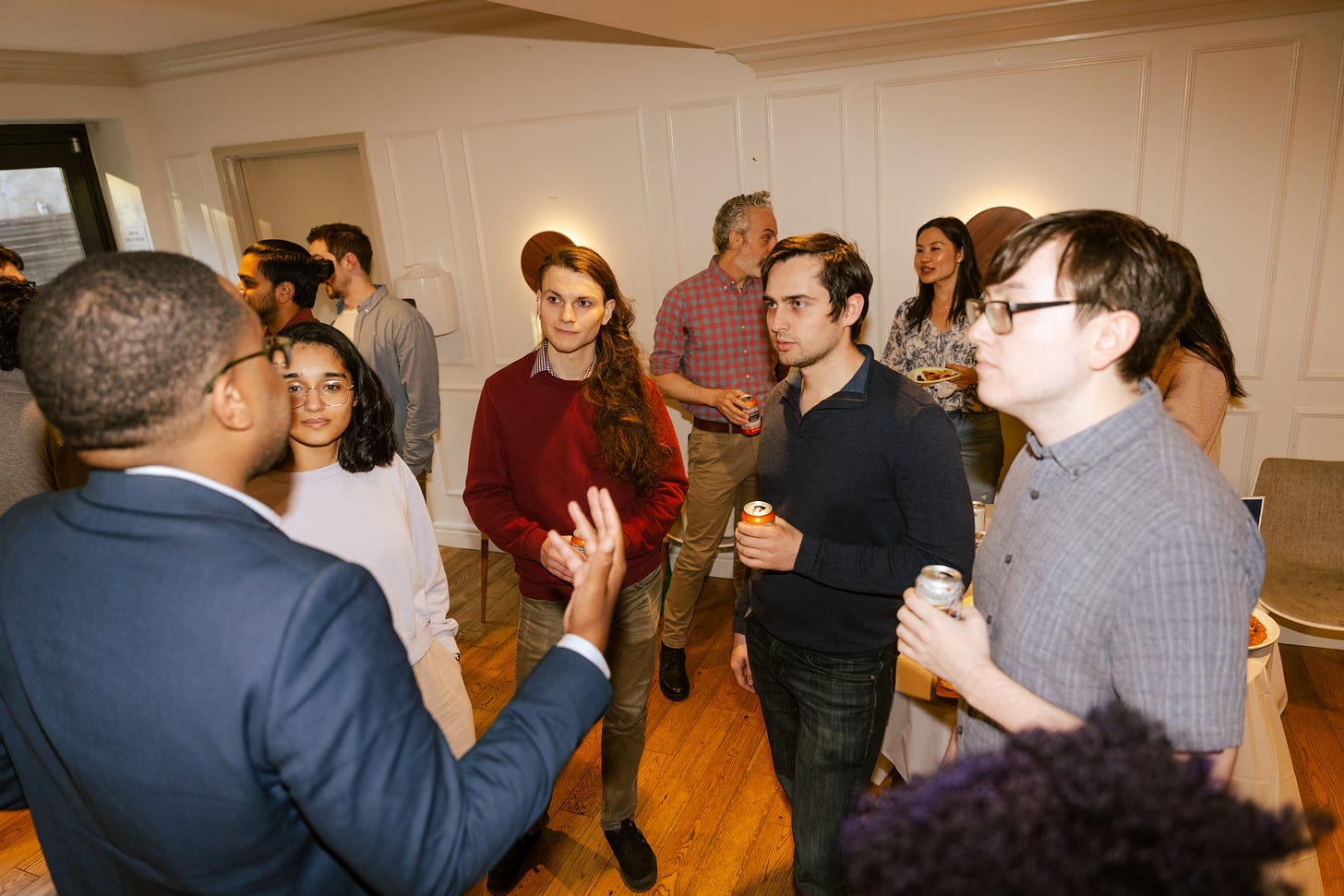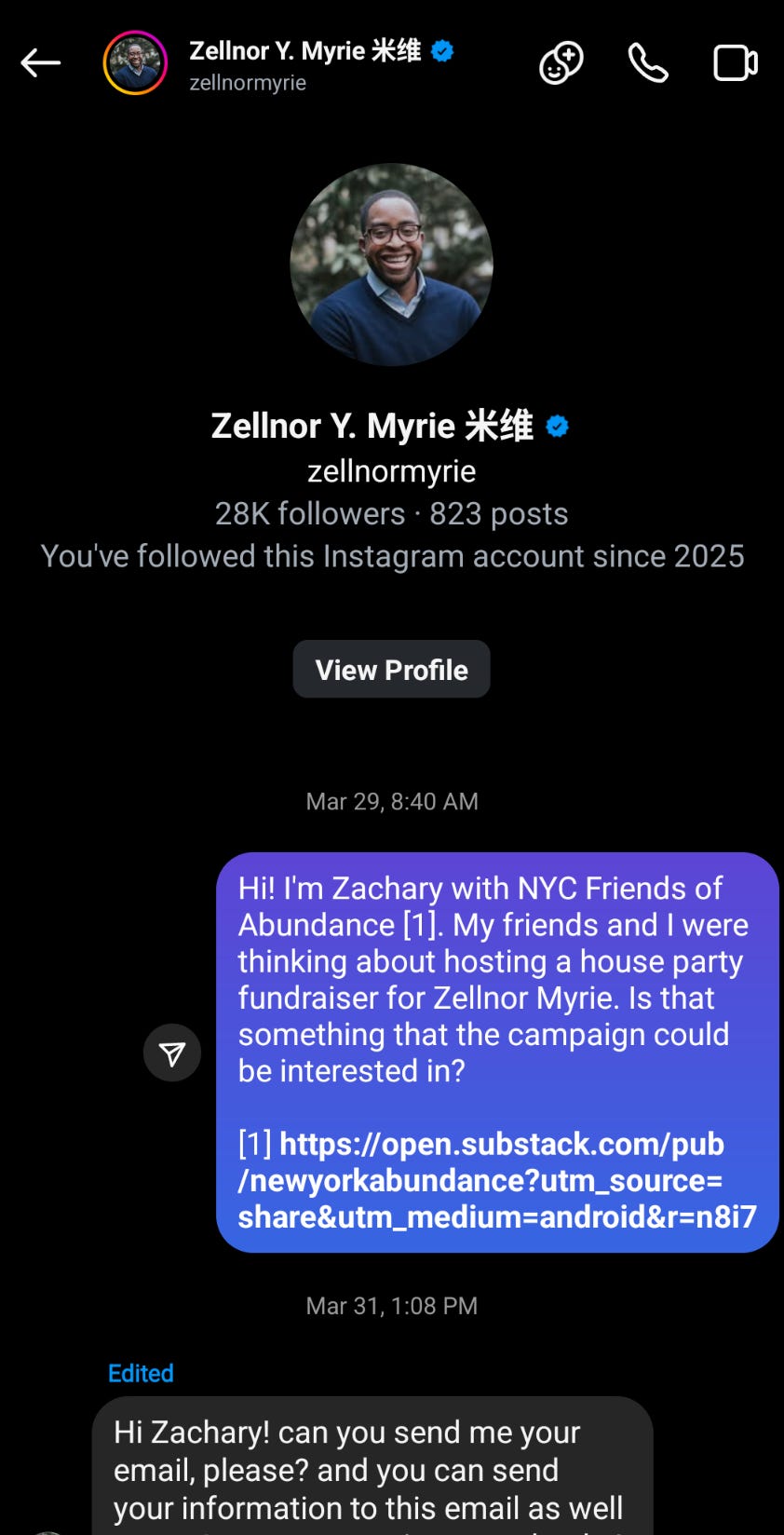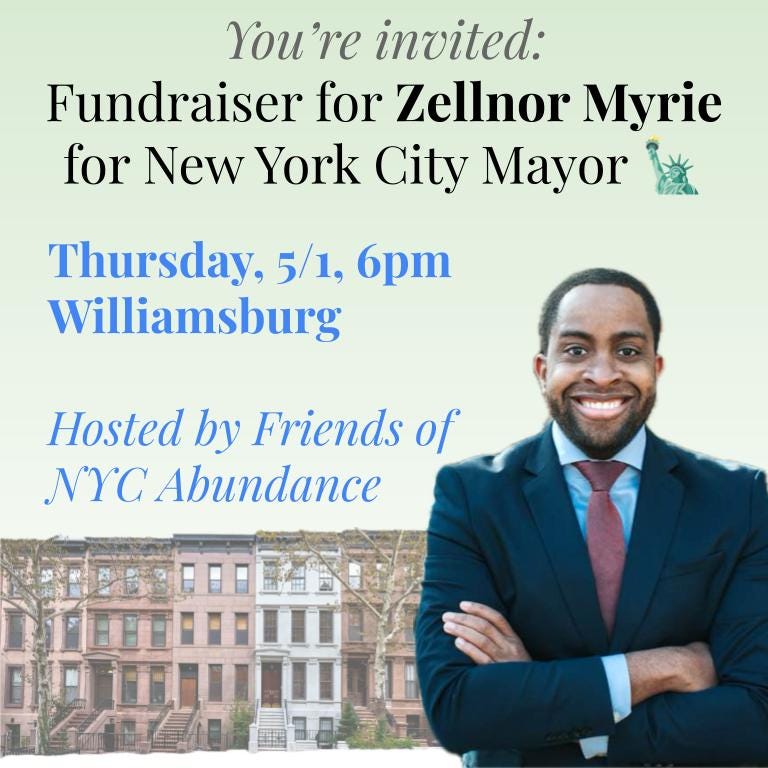A guide to hosting fundraisers for local candidates you care about
You don't need to be an expert or insider to make a dent in your local political universe
In early May, we hosted a fundraiser for Zellnor Myrie, raising over $13,200 for the campaign and giving over 20 attendees face time with the New York State Senator who is running to be Mayor of New York City.
The New York Times featured Myrie on its home page that same day (!!), so it felt even more special to spend time discussing the future of the city with him in-person.
The great news: this was my first time hosting a fundraiser and only my second time attending! The first time was last fall for Keith Powers’s campaign to be Manhattan Borough President. You can read more about that in this helpful guide from Sidewalk Chorus:
On a similar note, I wanted to spell out what my experience was like to demystify the process for others. If you are reading this article, you can host a fundraiser too.
Why host?
There are a lot of ways to be involved in the civic sphere in New York City and during election seasons. Overall, hosting a fundraiser is a service for your network and local democracy:
You can produce more informed voters: Multiple people who attended the event told me they didn’t arrive committed to voting for Myrie — they wanted to learn more so they could make an informed vote.
Face-to-face conversations are more authentic and memorable: Today a lot of political discourse happens in quick exchanges online. This makes an hour with a candidate feel even more valuable.
You will connect people with similar questions and views: Even as the host, I only knew only about half of the attendees. I really enjoyed meeting people curious about the Myrie campaign and Abundance politics — I’m sure attendees left with a similar feeling.
You can increase your own political capital: Once you host a fundraiser, campaigns and organizations may proactively reach out about hosting events, which is a great opportunity to also make sure your views are heard by the candidate.
Here are four easy steps to hosting a fundraiser:
Step 1: Reach out to the campaign
Don’t fret too much on how exactly you get this done. In fact, I reached out cold over an Instagram direct message:
This turned into a meeting. We discussed a couple of different topics:
When to host?
The campaign recommended happy hour during a week day or a weekend brunch time slot. We ended up hosting on a Thursday from 6-8pm.
Where to host?
I hosted in my building lounge, which I was able to rent out ahead of time. The campaign also mentioned bars or restaurants with space as a possible option.
Do you need a co-host?
I didn’t have a formal co-host for the event, although I asked within my network if people would be interested. I quickly found someone who was willing to pledge a substantial donation to the event. That gave me the confidence to commit to hosting. The Myrie campaign also offered to pair me with a co-host if needed.
After the meeting and a couple of emails, the event date was set a month in advance. The campaign provided an ActBlue link for people to RSVP through. The next step was getting the word out and sending invites.
Step 2: Invite people and market event
Conventional wisdom is that you need to invite three people for every attendee. I’m not sure I quite hit that ratio, but it is true that it can be difficult to know who in your network wants to attend a political fundraiser and is free at the time you are hosting.
Inviting people in your network
I would recommend creating a short message you can send individually to people. It is easy to lose a lot of time here customizing messages, so using a template or two is a better approach.
Finding attendees outside your network
Since the mayor’s race gets broad attention from voters, I made sure to post about the event in group chats for pro-housing and Abundance communities. In my case that included:
This newsletter (You're invited! Our fundraiser for Zellnor Myrie for New York City Mayor)
The Open New York Slack
The Abundance New York WhatsApp group
The Maximum New York Substack chat
The fundraiser also got mentioned in a Maximum New York Politics Roundup and by NYC Politics 101.
I was pleasantly surprised to meet people who found out about the fundraiser over Substack or a group chat — definitely don’t overlook these places for attendees.
Tracking RSVPs and fundraising pre-event
The Myrie campaign tracked RSVPs and donation amounts via a spreadsheet updated daily. If you host a fundraiser, ask for this information since otherwise it’s hard to tell who actually signed up and how fundraising is going.
Step 3: Host the event
The great news here is that most of the work for the event is already done by the time the fundraiser swings around. In fact, the fundraiser should be a social gathering you get to enjoy like the other attendees.
Knowing the schedule
The Myrie campaign crafted the schedule for our event, which ended up looking like:
Zellnor’s campaign manager arriving early to help set up for the event
30 minutes at the start (before Zellnor arrived) for attendees to mingle
15 minutes after Zellnor arrived for him to work the crowd
30 minutes for a stump speech and then a Q&A with the audience
Some farewells before Zellnor departed
Continued mingling until the end of the event
I knew I had to give a quick intro, so I prepped talking points on why I supported Zellnor and asked some fun questions to break the ice with the crowd before he began his stump speech.
Having appetizers and drinks ready
We didn’t think too hard about it, but we shopped at Trader Joe’s for some finger food we could warm up via an air fryer in addition to chips and salsa plus a charcuterie spread. In terms of drinks, we had regular and alcoholic seltzer.
Documenting the event
This was optional, but we paid for a friend who is a photographer to cover the event. That said, you or a co-host could take photos yourself to document the moment.
Step 4: Make some noise after the event
Now that you’ve hosted, make sure people know that it happened! This can include:
sharing photo from the event to social media
a quick write-up (or photo essay) about the event
looping back to the group chats about how the event went
(These steps apply both for the host and attendees!)
So there you have it — four easy steps to hosting a fundraiser for a candidate you care about. And if you do host, please let me know, I'll do my best to attend if I'm free.









Great hosts, great event, great candidate!